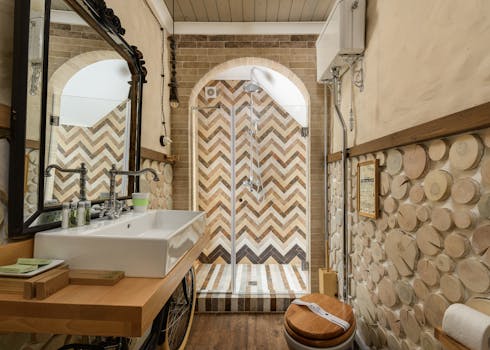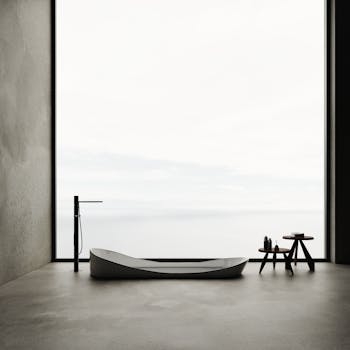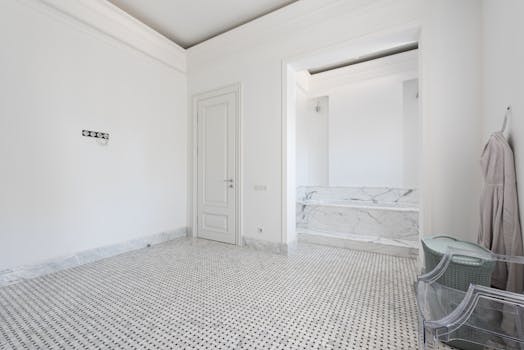Transform Your Bathroom with Unique Design Ideas and Tips
As the saying goes, “Home is where the heart is,” and for many, the heart of the home is the bathroom. It’s the place where we start and end our days, the room where we find tranquility amidst the chaos of life, and often, a personal sanctuary where we can unwind and relax. But more than its functionality, the design of a bathroom plays a pivotal role in enhancing our daily routines and overall home experience. This is why we’re going to delve into the world of bathroom design, discussing its immense importance, and the ways you can transform your ordinary bathroom into a luxurious retreat.
Bathroom design is a delicate balance of aesthetics, functionality, and personal taste. It’s not just about choosing the right color scheme or the trendiest tiles. It’s about creating a space that’s not only visually appealing but also caters to your specific needs and lifestyle. Whether it’s incorporating adequate storage for your toiletries, choosing the perfect lighting to set the mood, or even deciding on the placement of your fixtures, every single detail matters in bathroom design.
Moreover, a well-designed bathroom can significantly increase the value of your home. According to experts, bathroom renovations offer one of the highest returns on investment in home improvement. So, whether you’re planning to sell your home in the future or not, investing in your bathroom design is a smart move.
In this comprehensive guide, we will explore the art of creating exquisite bathrooms that exude elegance, style, and functionality. From understanding your bathroom layout to choosing the right unique design elements, we have got you covered. Let’s embark on this transformative journey of bathroom design and elevate your bathroom experience to new heights. Stay tuned for unique design ideas and tips that will help you transform your bathroom into a relaxing oasis.
Starting Your Bathroom Design: Where to Begin
Embarking on a bathroom design project can feel like opening a new chapter in your home’s story. It’s an exciting venture filled with endless possibilities. However, the key to a successful transformation lies in meticulous planning and clear vision. So, where exactly do you start when designing a bathroom?
Understanding Your Bathroom Layout
First things first: get to grips with your bathroom layout. This involves assessing the physical dimensions and characteristics of your bathroom — from the location of doors and windows to the placement of existing fixtures. Understanding how your bathroom space works is crucial whether you’re updating a small powder room or embarking on a large master bathroom renovation.
Plan a clear floor space of at least 30 inches from the front edge of all fixtures (lavatory, toilet, bidet, tub, and shower) to any opposite bath fixture, wall, or obstacle. Additionally, remember that a minimum space of 21 inches must be planned in front of the lavatory, toilet, bidet, and tub as per code requirements.
Identifying Your Bathroom Design Needs and Preferences
Next, hone in on your design objectives by identifying your needs and preferences. This is where you should consider the practicality and functionality of your bathroom design. Are you looking for a spa-like retreat for relaxation, or do you need a practical, family-friendly space? Do you prefer a minimalist, contemporary style, or are you drawn to traditional, classic designs?
Remember to think about your lifestyle and how it impacts your bathroom use. For instance, if you frequently rush in the mornings, consider a double vanity to avoid bathroom bottlenecks. Your bathroom should not only reflect your aesthetic taste but also cater to your unique lifestyle needs.
Creating a Checklist for Your Bathroom Design
Once you’ve identified your needs and preferences, it’s time to create a checklist for your bathroom design. This list will serve as your roadmap throughout the design process, ensuring you don’t overlook any critical elements.
Consider everything from the major fixtures like the toilet, shower, and sink, to the smaller details like taps, lighting, and storage options. Don’t forget about the finishing touches such as paint colors, tile choices, and accessories.
Lastly, gather inspiration for your bathroom design. Look through design magazines, browse online resources, or even visit showrooms to find styles and elements that resonate with you. Don’t rush this process – take your time to create a cohesive and personalized bathroom design that you’ll love for years to come.
Starting a bathroom design may seem daunting, but with careful planning and a clear vision, you can create a space that is both functional and aesthetically pleasing. Stay tuned for more tips on key elements of bathroom design in the next section.
Key Elements of Bathroom Design
If you’re looking to rejuvenate your bathroom, understanding the key elements of bathroom design is crucial. It’s not just about picking the right tiles or color scheme, but it’s about creating a room that is functional, comfortable, and matches your personal style.
Prioritizing Functionality in Your Bathroom Design
When starting your bathroom renovation, your first priority should be functionality. The bathroom is a space in which efficiency and practicality are paramount. When considering the layout, think about your storage needs and daily routines. As Lauren Sullivan of Well x Design points out, modern and traditional fittings can have different space requirements, so consider your style preferences early in the design process. Also, keep in mind that vanities with drawers often provide more storage options than those with doors.
Incorporating Adequate Storage in Your Bathroom Design
Remember, a bathroom is only as beautiful as its storage. Consider whether you need a linen cabinet, built-in, or closet, or if a vanity will provide enough storage. Also, don’t limit yourself to traditional storage options. With a variety of good-looking medicine cabinets available on the market, it’s easy to add functional storage that also enhances the aesthetic appeal of your bathroom.
Importance of Lighting in Bathroom Design
Lighting plays a significant role in setting the ambiance of your bathroom and ensuring it’s practical for daily use. You’ll want to include multiple sources of light, such as recessed lighting, wall sconces, and natural light. Also, consider the placement of these fixtures, especially around mirrors, to maximize their effectiveness.
Considering Special Features for Your Shower
Showers come with a variety of special features these days. Do you prefer a steam shower? Do you need a shower niche or a shaving ledge? Sullivan suggests considering whether your shower will be curbless or zero-entry, as these choices can significantly impact your budget.
Deciding on a Separate Toilet Room in Your Bathroom
When designing shared primary bathrooms, it can be beneficial to designate a separate toilet area with a closed door. This allows for more privacy and makes the room easier to share. However, be sure to check your local codes for standard allowances.
Placement of the Bathtub for a Relaxing Atmosphere
If you plan to include a bathtub in your bathroom design, consider placing it underneath windows. As Leslie Murphy of Murphy Maude Interiors suggests, this not only creates a relaxing, spa-like atmosphere, but also makes the most sense in terms of cabinetry placement.
Remember, your bathroom design should reflect your personal style and cater to your specific needs. Keep these key elements in mind as you transform your bathroom into a space that is both functional and beautiful.
Unique Bathroom Design Ideas
Unleash your creativity as you embark on your bathroom remodeling journey. With the right guidance and unique design ideas, you can transform your bathroom into a personal oasis that combines function and style. Here are some innovative suggestions to stir your imagination.
Mixing Metal Finishes for a Timeless Design
Dare to break the conventional rules by mixing metal finishes in your bathroom design. This approach not only creates visual interest but also leads to a more timeless design that won’t date as quickly. For instance, you could pair a brushed nickel faucet with brass cabinet hardware for a sophisticated look. In doing so, you bring a distinct character to your bathroom that transcends fleeting design trends.
Varying the Scale of Bathroom Tiles for Visual Interest
Another design element to consider is varying the scale of your bathroom tiles. This tactic can infuse your bathroom space with more visual interest and dimension. You might opt for large-format tiles on the floor and smaller, mosaic-style tiles on the shower walls. The contrast in scale will add an unexpected touch to your bathroom, making it a visually appealing space.
Using Attractive Medicine Cabinets for Storage
Gone are the days when medicine cabinets were purely utilitarian. Modern medicine cabinets come in a variety of styles and designs that contribute to your bathroom’s overall aesthetic while serving a functional purpose. Don’t shy away from using these attractive medicine cabinets as a storage solution. After all, a bathroom is only as beautiful as its storage.
Customizing Your Bathroom to Meet Personal Needs
Consider customizing your bathroom to meet your personal needs. If you prefer showers over baths, for instance, invest in a luxurious steam shower instead of a large soaking tub. Or, if you find that you require more storage space, opt for a vanity with drawers rather than doors. These personal touches will ensure your bathroom suits your lifestyle perfectly.
Creating a Spa-Inspired Bathroom
Elevate your bathroom experience by creating a spa-inspired retreat. This can be achieved by incorporating soothing elements like a freestanding bathtub, natural materials like stone and wood, dimmable lighting, and soft textiles. You could also introduce scented candles or essential oils for aromatherapy. Such a bathroom will serve as a sanctuary where you can unwind and rejuvenate.
Choosing Vanity Styles and Options
Lastly, the choice of vanity can significantly impact your bathroom’s overall look. The finish of your cabinetry is key as it can influence the selection of tiles and stones. You might choose a floating vanity for a minimalist aesthetic or a vintage-style vanity for a classic look. Additionally, consider vanities with drawers for maximum storage options.
In conclusion, there’s no one-size-fits-all when it comes to bathroom design. Each space is unique, and the best designs are those that reflect the homeowner’s personal style and meet their specific needs. With these unique design ideas, you’re well on your way to creating a bathroom that’s truly your own.
Planning Your Bathroom Design with RoomSketcher
Imagine having the power to visualize your dream bathroom before a single tile is laid or fixture installed. With RoomSketcher, an intuitive online bathroom planner, this is not only possible but enjoyable and straightforward too. This tool allows you to create a virtual model of your bathroom, experiment with various design elements, and see your ideas come to life in 3D. Let’s explore how you can use RoomSketcher to plan and perfect your bathroom design.
Creating 2D and 3D Floor Plans of Your Bathroom Design
The first step to actualizing your bathroom renovation is creating a floor plan. With RoomSketcher, you can generate a 2D layout of your bathroom from scratch or modify a basic room shape to fit your space. The drag-and-drop drawing tools make this process a breeze. Moreover, you can create a floor plan of both your existing and new bathroom. Having these two layouts handy will provide a clear picture of the changes required and aid in efficient project execution.
Adding Finishes to Your Bathroom Design
After setting up your floor plan, the next step is to add finishes to your bathroom’s floor, walls, and ceiling. With a simple click, you can choose different finishes such as tile or stone and drag them to the suitable place in your design. This feature allows you to experiment with various materials and colors, helping you to select the perfect finishes that complement your style and the overall aesthetic of your bathroom.
Previewing Your Bathroom Design in 3D
RoomSketcher shines when it comes to offering a 3D view of your bathroom. The integrated camera tool allows you to preview your design from any angle, offering a realistic view of how your renovated bathroom will look. You can adjust the camera settings to get a wide overview or a close-up of specific areas. This feature is incredibly beneficial as it lets you catch any potential design flaws before the actual renovation begins.
Visualizing Your Bathroom Design Ideas Before Committing
One of the main advantages of using RoomSketcher is the ability to visualize your bathroom design before committing to any decisions. You can play around with different wall colors, tile patterns, fixtures, and more to see how they look together in your space. This can save you from costly mistakes and help ensure that your bathroom remodel reflects your personal style and meets your needs.
In conclusion, planning your bathroom design with RoomSketcher can take the guesswork out of your renovation process. By providing a clear visual representation of your design ideas, you can confidently make informed decisions and create a bathroom that you will love for years to come. Next, we will explore how to budget and implement your bathroom design effectively.
Budgeting and Renovation Tips for Your Bathroom Design
Taking a step back from the exciting world of design ideas, it’s essential to also consider the more practical aspects of a bathroom remodel. Budgeting, evaluating your existing space, making inclusive design decisions, and deciding whether to DIY or hire a professional are all crucial steps in the process.
Assessing Costs for Your Bathroom Design
When planning a bathroom remodel, the first thing you need to determine is your budget. The cost of a bathroom redesign can range from a few thousand dollars for a simple refresh to tens of thousands for a luxury transformation. The scope of your project, the quality of your materials, and your geographic location will all affect the final price. It’s important to do your research, obtain quotes from multiple contractors and suppliers, and consider all potential costs, including contingency funds for unexpected expenses. Prioritizing your spending based on your needs and preferences will also help you make the most of your budget.
Evaluating Your Existing Bathroom Space
Before you begin the design process, take the time to assess your current bathroom. Consider the layout and how it can be improved to better suit your needs. If your bathroom feels cramped or inefficient, it might be worth considering a new layout or even expanding the space. Remember to consider the location of existing plumbing and electrical systems, as moving these can add significant costs to your project.
Considering Universal Design Principles in Your Bathroom Design
When designing your bathroom, it’s also important to consider universal design principles. These guidelines aim to make spaces accessible and comfortable for all users, regardless of age, size, or ability. Features like a walk-in shower, grab bars, and a floating vanity can make your bathroom safer and more accessible. Incorporating these principles into your design not only makes your bathroom more functional but can also boost its resale value.
DIY Bathroom Projects vs Hiring Contractors
Finally, you need to decide whether you want to tackle the renovation yourself or hire professionals. DIY projects can save money, but they also require time, skills, and a good deal of patience. Hiring a contractor, on the other hand, can ensure that the job is done correctly and efficiently, but it will add to your costs. Consider your own abilities and the complexity of the project before deciding which route to take.
Remember, a successful bathroom remodel requires careful planning and thoughtful decision-making. By considering all aspects of the process, from budgeting to design principles, you can create a beautiful and functional bathroom that you’ll enjoy for years to come.
Conclusion: Transform Your Bathroom with Unique Design Ideas and Tips
Turning your bathroom into a functional and aesthetically pleasing space doesn’t have to be an uphill task. With the right design ideas and strategies, you can transform your bathroom into a personal sanctuary that mirrors your taste and lifestyle. Whether you are looking for a minimalist, spa-inspired retreat, a nature-inspired oasis or a space that perfectly integrates smart technology, the possibilities are endless.
One way to start is to think creatively about natural light. While sticking to conventional design might seem safe, pushing the boundaries by exploring less traditional elements can make a significant difference. For instance, constructing your bathroom walls with translucent corrugated sheets of polycarbonate plastic not only lets natural light in but also ensures privacy.
Another interesting idea to consider is switching your laundry and bathroom locations. While it may not be the most conventional approach, it could potentially improve your space’s flow and functionality. However, it’s important to assess the feasibility of this option in relation to your home’s layout and your specific needs.
When it comes to fixtures, you might want to consider slimming down your sink or even combining two rooms for a more spacious feel. Additionally, consider adding elements such as a fireplace in your bathroom for added relaxation and a luxurious vibe.
In the realm of technology, incorporating smart features into your bathroom design could significantly enhance convenience and energy efficiency. From motion-sensor faucets and lighting to programmable shower systems, the options are vast.
Designing your bathroom with RoomSketcher can also be a game-changer, allowing you to visualize your bathroom style before committing. You can easily try out different colors, materials, and styles, giving you a clear picture of what to expect.
Finally, always bear in mind that your bathroom remodel should reflect your personal preferences, budget, and the overall style of your home. Whether you’re going for small upgrades or a full overhaul, the goal is to create a space that echoes your personality while providing functionality and comfort.
With these unique design ideas and tips, you are well on your way to creating the bathroom of your dreams. So why wait? Begin your journey towards a bathroom transformation today!




